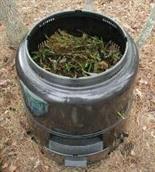
Composting is the breakdown of organic material (such as kitchen and garden waste) by micro organisms in a controlled environment.
Up to 60% of household rubbish entering landfill sites comprises of garden and kitchen waste which could be composted and therefore be saved from landfill.
Composting is very simple and costs very little in terms of money and time / effort.
Why Compost?
Saves Money:
By composting biodegradable waste you will be reducing the weight of your house hold bin waste, which means the council will save money which they can invest elsewhere.
You will also be producing a fertile compost which will increase plant growth in your garden. This will mean you will not have to buy compost from your local garden centre.
Helps Reduce Greenhouse Gas Emissions:
Due to the lack of oxygen in landfill sites, organic waste that is sent there biodegrades very slowly under anaerobic conditions. This produces harmful greenhouse gases such as methane and carbon dioxide.
Organic waste that is sent to compost sites will biodegrade under aerobic conditions and so will produce fewer green house gases.
Build ups of gases in landfill sites can be potentially explosive, which is a danger to people and the environment around the site. This means that most landfill sites have a system which collects the gas and burns it in a controlled manner.
Reduction In Peat Usage:
Reduction in peat usage helps to preserve an important natural habitat, where only specific species may be able to survive.
It also helps to reduce the amount of greenhouse gases emitted through burning peat, which is estimated to contain 1 billion tonnes.
Proximity Principle:
By converting a locally occurring waste in to a useful resource, you reduce the need for transport so fewer green house gases are emitted.
What To Compost?
Organic materials fall into two categories – Green and Brown.
Green organic waste
Also known as ‘nitrogen rich’ organic waste. It is wet and often green – eg grass clippings and vegetables.
Brown organic waste
Also known as ‘carbon rich’ organic material. It is dry, woody material that is usually brown – eg leaves.
To get a good compost that will enrich your soil a blend of both green and brown waste is the most efficient.
What not to compost:
Meat and fish scraps
Attracts pests to the compost heap which will disrupt the composting process. Meat breaks down differently to vegetable matter taking a much longer time. It also may present a health hazard to humans and handling the compost becomes more tricky. If you must compost meat and fish burn them to ash and put that on the compost.
Grease and oil
Slow to decompose and attract pests
Cat litter or cat and dog droppings
Temperature of the bin is too low to kill any diseased cells (pathogens) that may effect human.
Glossy paper or magazines
Plastic coating will not compost.
Barbecue and coal ashes
Coals have been chemically treated and will contaminate the compost.
Large woody material
Slow to compost.
Evergreen shrubs
Highly acidic which will drive worms
away and kill bacteria.
Garden wastes that have been treated with chemicals
This will chemically contaminate the
Compost and kill decomposers.
Disposable nappies or septic tank waste
Temperature of the bin too low to kill any diseased cells (pathogens) that may effect human health.
Soil
Slows down the decomposition process.
How to compost:
Stage 1
Compost breaks down best in the shade, where it won’t dry out from exposure to the sun. Place the bin where it can be accessed, added to and turned easily. It is also a good idea to place the bin directly on soil/grass, where it can benefit from decomposers such as worms.
Stage 2
Protect your compost bin from heavy rain as it may waterlog the bin and starve it of air, which will hinder the composting process.
Stage 3
To begin, start at the bottom of the bin with bigger, bushy materials such as woody pruning's to make air pockets in the pile. Alternate layers of brown and green waste to make a good mix. Moisten each layer with water. Use a fork to mix and aerate layers, similar to tossing a salad. Top the pile with a layer of browns, aged compost or soil. Do not forget the vital mix of brown’s and green’s in equal measure.
Stage 4
The compost is ready when it has a brown and crumbly texture. It can then be put back into the garden. The time taken to get to this stage could be from 4months to a year.
Composting Containers:
Compost bins are made from recycled plastic and they require little or no maintenance.
The Quick Compost Tumbler:
This is suitable for larger gardens. It is suspended with a bar through the centre so that you can turn the contents. Although the compost is produced a lot faster it is more labour intensive.
The Wormery:
This looks similar to the compost bin but has a solid base to contain the worms, which accelerate the composting process. The wormery produces high quality compost but is only suitable for fruit and vegetable waste, not garden waste.
Fascinating Facts:
- Approximately 7.5 million tonnes of organic waste is thrown away every year
- Compost worms breed every 7–10 days and eat half their body weight in food every day
- If the UK were to compost all of its green waste the amount sent to landfill would reduce by 20%
- Modern composting techniques were invented in the early 1920’s. However man has been composting ever since 0AD